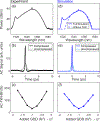Stretched-Pulse Soliton Kerr Resonators
- PMID: 32745409
- PMCID: PMC7433351
- DOI: 10.1103/PhysRevLett.125.033902
Stretched-Pulse Soliton Kerr Resonators
Abstract
Kerr resonators support novel nonlinear wave phenomena including technologically important optical solitons. Fiber Kerr resonator solitons enable wavelength and repetition-rate versatile femtosecond-pulse and frequency-comb generation. However, key performance parameters, such as pulse duration, lag behind those from traditional mode-locked laser-based sources. Here we present new pulse generation in dispersion-managed Kerr resonators based on stretched-pulse solitons, which support the shortest pulses to date from a fiber Kerr resonator. In contrast to established Kerr resonator solitons, stretched-pulse solitons feature Gaussian temporal profiles that stretch and compress each round trip. Experimental results are in excellent agreement with numerical simulations. The dependence on dispersion and drive power are detailed theoretically and experimentally and design guidelines are presented for optimizing performance. Kerr resonator stretched-pulse solitons represent a new stable nonlinear waveform and a promising technique for femtosecond pulse generation.
Figures




References
-
- Diddams SA, J. Opt. Soc. Am. B 27, B51 (2010).
-
- Kippenberg TJ, Holzwarth R, and Diddams SA, Science 332, 555 (2011). - PubMed
-
- Suh MG, Yang QF, Yang KY, Yi X, and Vahala KJ, Science 354, 600 (2016). - PubMed
-
- Spencer DT, Lee SH, Oh DY, Suh M-G, Yang KY, and Vahala K, Nature 557, 81 (2018). - PubMed
-
- Udem T, Holzwarth R, and Hänsch TW, Nature 416, 233 (2002). - PubMed
Grants and funding
LinkOut - more resources
Full Text Sources
